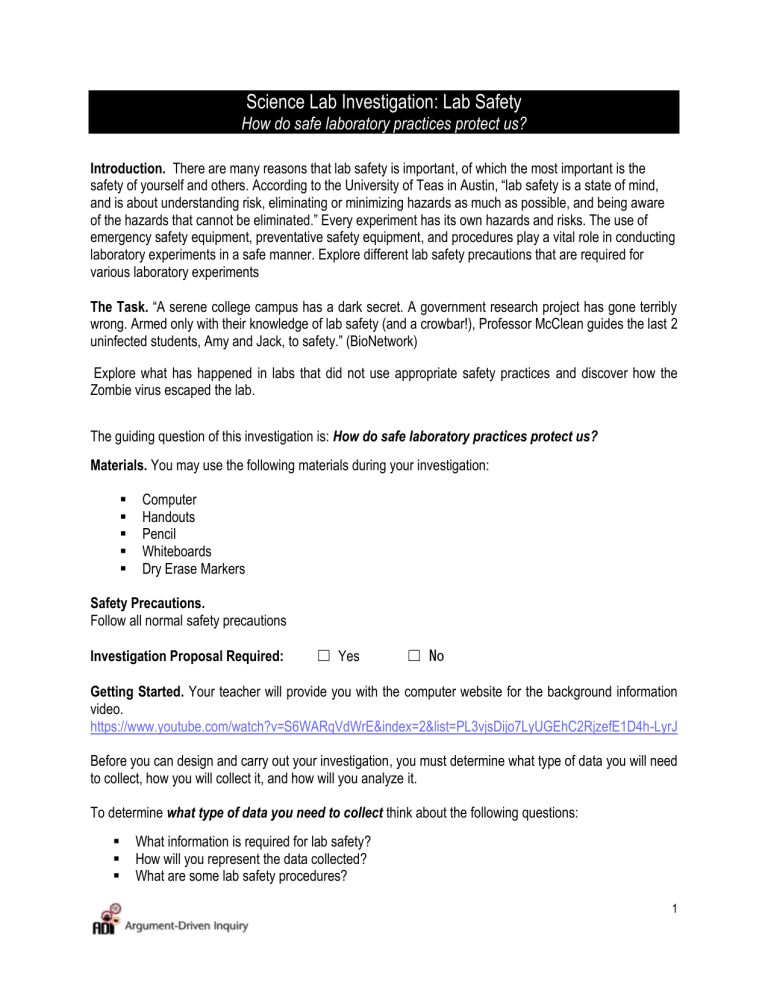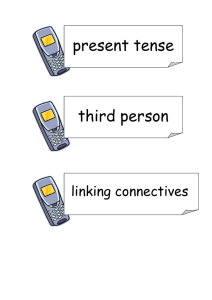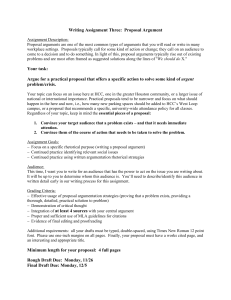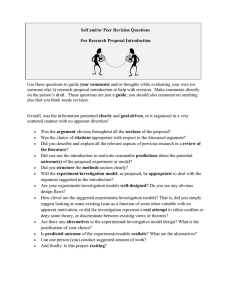
Science Lab Investigation: Lab Safety How do safe laboratory practices protect us? Introduction. There are many reasons that lab safety is important, of which the most important is the safety of yourself and others. According to the University of Teas in Austin, “lab safety is a state of mind, and is about understanding risk, eliminating or minimizing hazards as much as possible, and being aware of the hazards that cannot be eliminated.” Every experiment has its own hazards and risks. The use of emergency safety equipment, preventative safety equipment, and procedures play a vital role in conducting laboratory experiments in a safe manner. Explore different lab safety precautions that are required for various laboratory experiments The Task. “A serene college campus has a dark secret. A government research project has gone terribly wrong. Armed only with their knowledge of lab safety (and a crowbar!), Professor McClean guides the last 2 uninfected students, Amy and Jack, to safety.” (BioNetwork) Explore what has happened in labs that did not use appropriate safety practices and discover how the Zombie virus escaped the lab. The guiding question of this investigation is: How do safe laboratory practices protect us? Materials. You may use the following materials during your investigation: Computer Handouts Pencil Whiteboards Dry Erase Markers Safety Precautions. Follow all normal safety precautions Investigation Proposal Required: ☐ Yes ☐ No Getting Started. Your teacher will provide you with the computer website for the background information video. https://www.youtube.com/watch?v=S6WARqVdWrE&index=2&list=PL3vjsDijo7LyUGEhC2RjzefE1D4h-LyrJ Before you can design and carry out your investigation, you must determine what type of data you will need to collect, how you will collect it, and how will you analyze it. To determine what type of data you need to collect think about the following questions: What information is required for lab safety? How will you represent the data collected? What are some lab safety procedures? 1 To determine how you will collect your data, think about the following questions: How will I organize the data (chart, graph, etc.)? What key words do I need for the search engines? In order to determine how you will analyze your data think about the following questions: How will I compare the lab procedures? How will I determine what procedures failed? How will I determine what caused the procedure failure? How will I determine the severity of the outcome of the failed procedure? How will I determine the cause of the virus escaping the lab? Connections to Crosscutting Concepts and the Nature of Science and Scientific Inquiry. As you work through your investigation, be sure to think about: The purpose of laboratory procedures Models that can be used to compare lab procedures The purpose of emergency safety equipment and when to use The purpose of preventative safety equipment and when to use Initial Argument. Once your group has finished collecting and analyzing your data, your group will need to develop an initial argument. Your initial argument needs to include a claim, evidence to support your claim, and a justification of the evidence. The claim is your groups’ answer the guiding question. The evidence is an analysis and interpretation of your data. Finally, the justification of the evidence is why you group thinks the evidence matters. The justification of the evidence is important because scientists can use different kinds of evidence to support their claims. You group will create your initial argument on a whiteboard. Your whiteboard should include all the information shown in figure at right. Argument Presentation on a Whiteboard Argumentation Session. The argumentation session allows all of the groups to share their arguments. One member of each group will stay at the lab station to share that group’s argument, while the other members of the group go to the other lab stations to listen to and critique the other arguments. This is similar to how scientists present their arguments to other scientists at conferences. If you are responsible for critiquing your classmates’ arguments, your goal is to look for mistakes in your classmates’ arguments so these mistakes can be fixed and they can make their argument better. The argumentation session is also a good time to think about ways you can make your initial argument better. Scientists must share and critique arguments like this in order to develop new ideas. 2 In order to critique an argument, you might need more information than what is included on the whiteboard. You will therefore need to ask the presenter lots of questions. Some good questions to ask might be: What did your group do to collect the data? Why do you think that way is the best way to do it? What did your group do to make sure that the data is accurate? Is there other data that your group would like to have? If so, what is it? What did your group do to analyze the data? Why did your group decide to analyze it that way? What did your group do to make sure that these calculations are correct? What other ways of analyzing and interpreting your data did your group talk about? Why did your group decide to present your evidence in that way? What other claims did your group discuss before you decided on that one? Why did your group abandon those other ideas? How sure are you that your group’s claim is accurate? What could you do to be more certain? Once the argumentation session is complete, you will have a chance to meet with your group and revise your initial argument. Your group might need to gather more data or design a way to test one or more alternative claims as part of this process. Remember, your goal at this stage of the investigation is to develop the best argument possible. Report. Once you have completed your research, you will need to choose one of the following ways to defend your position. 1. 2. 3. 4. Prepare an Investigation Report Prepare a Slide Presentation Prepare a Poster Presentation Prepare a Tri-Fold Poster Presentation Each type of presentation must have at least three sections. Each section should provide an answer for the one following questions: a. What question were you trying to answer and why? b. What did you do during your investigation and why did you conduct your investigation in this way? c. What is your argument? This report must be typed and any diagrams, figures, or tables should be embedded into the document. Be sure to write in a persuasive style; you are trying to convince others that your claim is acceptable or valid! 3






